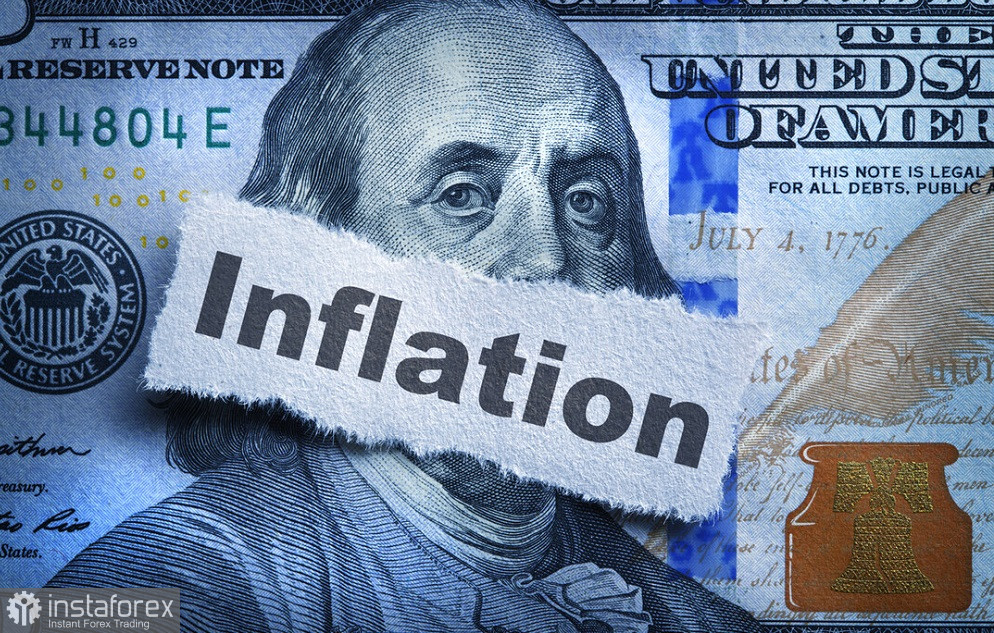The dollar is plunging across the market following the publication of June's inflation growth data in the US. The release was in the "red zone": all report components fell short of forecast values. Most experts expected inflation to slow down, but not at such a rapid pace. Given this circumstance, the reaction of the greenback seems justified. Today's release will "haunt" the dollar bulls for many days and weeks to come, all the way to the Federal Reserve meeting in July, which will occur at the end of this month. In other words, the dollar took a powerful blow today and was knocked out.
So, the overall consumer price index every month came out at 0.2%, with a growth forecast of 0.3%. The annual overall CPI was also in the "red zone": with a decline forecast to 3.1%, the figure dropped to 3.0% (in May, this figure was at 4.0%). This is the weakest pace of growth since March 2021.
The core consumer price index, excluding food and energy prices, also fell short of forecast values. On a monthly basis, the figure came out at 0.2% (after a 0.4% increase in May), and on an annual basis - at 4.8% with a forecast of 5.0%. It should be noted that this component also showed a downward trend in April and May.

The structure of today's report indicates that energy prices in May fell by 16.7% after a decrease of 11.7% in May. Additionally, the increase in food prices has slowed down significantly: in June, prices rose by 5.7% after an increase of 6.7% a month earlier.
Overall, price growth has been slowing for the 12th consecutive month, and this fact cannot but worry dollar bulls. However, the market reaction speaks for itself: the US dollar index hit a two-month low, and the EUR/USD pair, in turn, hit a 16-month price high, testing the 11-figure mark.
The consequences of the release
Notably, according to the CME FedWatch Tool, the probability of a 25-point interest rate increase at the July meeting is currently 93%. This means that despite the weak inflation report, the market has almost a hundred percent certainty that the US regulator will further tighten monetary policy parameters this month. However, the market is ignoring this hawkish circumstance, as dollar pair traders have long factored in the July increase. The further prospects for tightening monetary policy are quite vague, and today's release has only intensified experts' doubts about another hike this year (after the July meeting).
According to the above-mentioned CME FedWatch Tool, the likelihood of a rate increase at the September meeting is only 12%, while the probability of maintaining the status quo is 80% (assuming a July increase). A similar forecast scenario has been formed regarding the October meeting.
It should be remembered that Jerome Powell was voicing rather hawkish rhetoric throughout June, providing underlying support for the greenback. However, he constantly shifted emphases in his speeches, trying to maintain a certain balance. For instance, following the June meeting, Powell put pressure on the greenback (even though the text of the accompanying statement was hawkish) - he stated that the regulator would continue making decisions "from meeting to meeting." The decision to pause will allow the Central Bank to gather more information before deciding whether to raise rates again or not, as the pace of tightening monetary policy "is now less important than finding the final point of the current cycle."
Then, speaking in Congress, Jerome Powell somewhat tightened his position, stating that US inflation is still unacceptable. Therefore, the Federal Reserve has no other option but to raise the rate further. At the same time, he allowed for two rate increases by the end of 2023 ("it will be appropriate to raise rates again this year, possibly twice more").
And finally, during his last "thematic" speech at the ECB forum, the head of the Federal Reserve stated that the overwhelming majority of the members of the US regulator expect "two or more rate hikes by the end of this year."
After the publication of June's inflation, the rhetoric of the head of the Fed (like many of his colleagues) will gradually soften. The main leitmotif will be that the dot plot, updated in June (implying two increases this year) - is not an action guide. Powell has already voiced this thought after the June meeting, in the context that the Central Bank does not raise the rate according to a predetermined trajectory.
Conclusions
Inflation in the US slowed down more than forecasted in June, putting significant pressure on the dollar. I believe the remaining inflation reports to be published this week (Producer Price Index, Import Price Index) will also be in the "red zone," exerting additional pressure on the greenback.
The established fundamental backdrop favors the further development of the ascending movement of EUR/USD. The immediate target is the 1.1130 mark (the upper line of the Bollinger Bands on the weekly chart). If buyers consolidate above this target, they will open their way to the 12-figure mark.





















